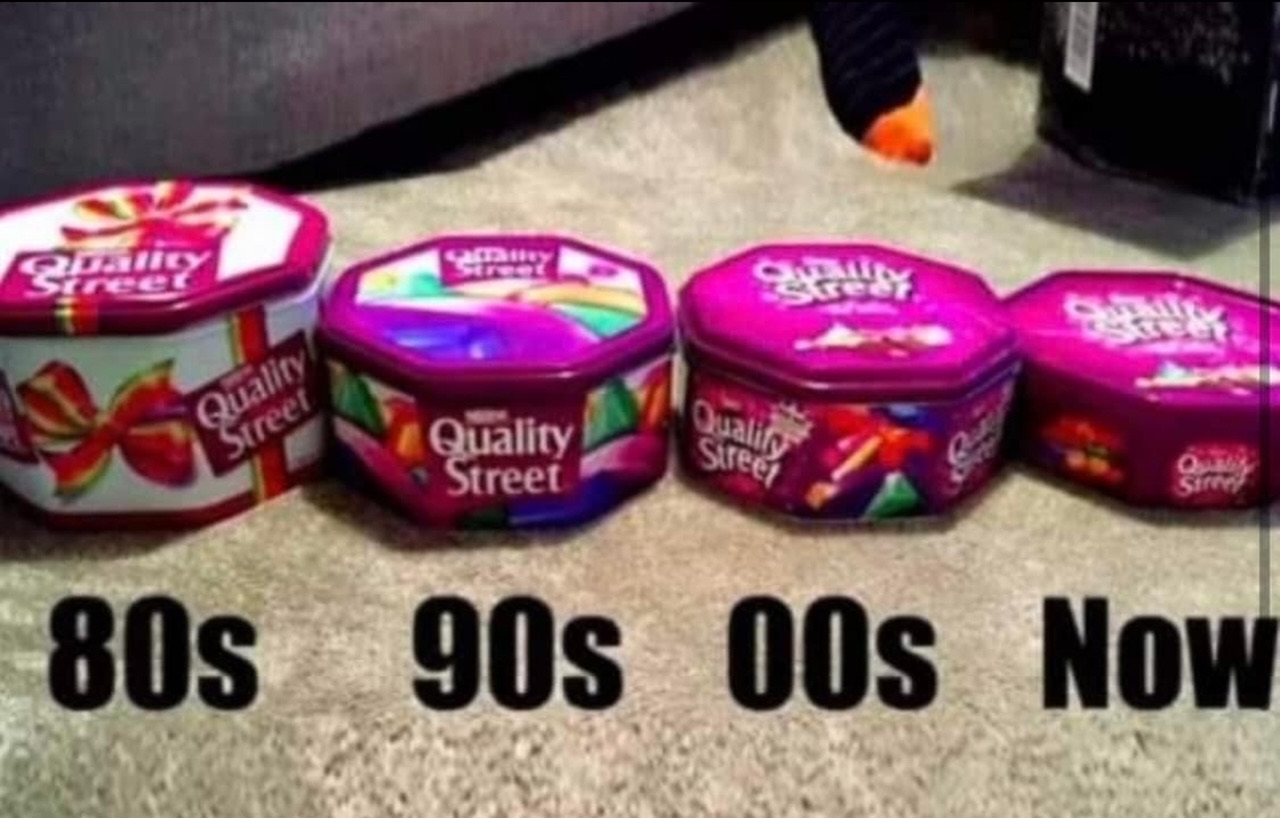Table of Contents
Navigating Economic Turbulence – What Inflation, Deflation, Stagflation, Hyperinflation, and Shrinkflation Mean for You
Welcome to a journey through the economic landscape, uncovering the mysteries of inflation, deflation, stagflation, hyperinflation, and shrinkflation. In this post, we decode these economic terms in simple language, revealing their impact on your wallet and the wider economy.
Join us as we demystify these economic concepts, from inflation’s sneaky erosion of your purchasing power to the chilling stagnation of deflation, the puzzling dance of high prices and slow growth in stagflation, and the catastrophic tempest of hyperinflation. We’ll also uncover the subtle but impactful squeeze of shrinkflation, where products shrink unnoticed, affecting your wallet.
Using relatable examples and straightforward explanations, we’ll explore how these economic trends have historically affected the UK and what they mean for you as individuals as well as businesses, and financial stability. Get ready to understand the causes, historical context, and strategies for navigating through these economic storms.
Let’s unravel the puzzles of inflation, deflation, stagflation, hyperinflation, and shrinkflation together, unlocking their significance and offering insights for safeguarding your financial future.
Understanding Inflation: The Stealthy Thief of Purchasing Power
Inflation, akin to a crafty trickster, silently siphons the value of your money over time. It’s the stealthy rise in the prices of goods and services, making your pounds and pence in your wallet buy fewer items than before.
Picture wandering through your local market, eyeing your cherished chocolate bar that once cost a mere 50 pence a few years ago. Today, it’s priced at a pound. That’s inflation in action – a gradual hike in the cost of goods, eroding the purchasing power of your money.
Now, consider refuelling your car. A decade back, £40 could fill your tank, but today that same fuel might demand £70. This persistent uptick in prices embodies inflation, affecting groceries, gadgets, rent, and bills.
Central banks play a pivotal role in this financial tale. Increased money supply—achieved through tools like quantitative easing (QE) or printing more currency—adds fuel to the inflationary fire. When central banks flood the market with more money, it can boost spending but also risk spurring inflationary pressures.
Historically, the UK has witnessed inflationary episodes due to such monetary policy measures. For instance, after the 2008 financial crisis, central banks initiated quantitative easing, injecting substantial amounts of money into the economy. While it aimed to stimulate growth, it also contributed to inflationary pressures, nudging prices upwards across various sectors.
Recognising inflation’s stealthy presence is crucial. Awareness empowers individuals to consider wealth preservation strategies like investing in assets such as gold and silver. These precious metals act as hedges against inflation, safeguarding the value of wealth amidst the erosive effects of rising prices.
What about Deflation?
While inflation might seem like the more notorious troublemaker, deflation silently creeps in, casting its icy chill over the economy. It’s the opposite of inflation—a decrease in the general price level of goods and services, where things become cheaper over time.
Imagine strolling through town, eyeing the latest gadgets or fashionable attire. Instead of the usual buzz of sales and promotions, you notice prices slowly ticking downward. That’s deflation – when prices gradually drop, tempting you to hold off on purchases in anticipation of even lower prices tomorrow.
In the UK, deflationary periods cast a long shadow, and history offers a glimpse of their effects. Take the Great Depression of the 1930s as an example. During this time, prices tumbled across the board, causing consumers to delay spending in hopes of snagging better deals later. This delay in spending leads to reduced demand, affecting businesses and their ability to thrive.
When prices consistently fall, businesses find themselves in a bind. They may reduce production, cut wages, or even face closure. Lower revenues mean fewer investments and, in turn, fewer jobs. This cycle of declining prices and economic activity becomes a chilling spiral, impacting individuals and the economy at large.
In a deflationary environment, debt also becomes a heavier burden. Picture having a mortgage or loan – while your salary stays the same, the value of your debt becomes relatively higher as prices decline. This can lead to challenges in repaying debts and may stifle economic growth.
Precious metals like gold and silver hold an intriguing role during deflationary times. While they may not actively generate interest like some investments, their value tends to remain more stable. Investors often turn to these precious metals as a safe haven, a shelter from the stormy economic weather of deflation.
Navigating the icy waters of deflation requires thoughtful consideration. Central banks might step in by reducing interest rates or injecting money into the economy to combat its effects. However, striking the right balance to thaw the economy without sparking inflation remains a delicate task.
Understanding deflation empowers individuals and investors to weather economic storms. As the winds of change blow, recognising the nuanced dance between inflation and deflation becomes pivotal in charting a course towards financial stability and safeguarding wealth.

Claim 10 Grams of FREE Silver
Stagflation. The Economic Conundrum
It’s scenario where prices soar while economic growth stagnates, causing a headache for policymakers and the public alike.
Imagine traversing through a time when prices climb relentlessly, yet jobs remain scarce, and growth stagnates. That’s stagflation – an odd pairing where high inflation couples with sluggish economic activity, creating a tricky environment to navigate.
Historically, the UK faced a brush with stagflation in the tumultuous 1970s. During this time, oil prices surged dramatically, propelling overall prices upward while growth slowed to a crawl. This confluence of rising prices and economic stagnation presented a formidable challenge for policymakers.
The conundrum of stagflation baffles most economists. Typically, inflation accompanies robust economic growth, but stagflation breaks this traditional bond. High prices squeeze household budgets, reducing consumer spending and business investments. Simultaneously, slow economic growth hinders job creation and prosperity, forming a vicious cycle.
Central banks often find themselves in a quandary during stagflation. Traditional tools like adjusting interest rates may prove ineffective – raising rates to combat inflation might further stifle economic growth, exacerbating the problem.
The role of precious metals during stagflation garners attention. Gold and silver, often seen as havens during uncertain times, can offer stability in the stormy waters of stagflation. Their intrinsic value and historical store of wealth make them appealing to investors seeking refuge from the economic storm.
While stagflation remains a puzzling phenomenon, its comprehension forms a crucial piece in the broader puzzle of economic cycles. As policymakers and individuals seek solutions, the role of precious metals as a stalwart against the perplexities of stagflation stands prominent in safeguarding wealth.
Hyperinflation: The Devastating Economic Effects.
Hyperinflation unleashes chaos by spiralling prices out of control. It’s a catastrophic phenomenon where prices soar exponentially, leaving a trail of financial ruin in its wake.
Visualise a scenario where prices rocket skyward by the hour, making yesterday’s prices seem like a distant dream. That’s hyperinflation – a frenzied surge in prices, eroding the value of money at a breathtaking pace.
Throughout history, various countries have grappled with the harrowing effects of hyperinflation. Germany’s Weimar Republic in the early 1920s stands as a stark example. At its peak, prices skyrocketed to absurd levels, leading to the infamous tales of people carrying wheelbarrows of cash to buy a loaf of bread.
Zimbabwe faced a similar nightmare in the late 2000s, witnessing astronomical price increases. The country experienced jaw-dropping hyperinflation, rendering its currency practically worthless. Citizens faced the dire consequences, struggling to afford basic necessities amid the economic turmoil.
Hyperinflation’s impact is widespread and severe. It obliterates savings, destroys purchasing power, and sparks economic chaos. People rush to spend money as quickly as possible, leading to shortages and a breakdown in economic transactions.
The root causes of hyperinflation often lie in a perfect storm of economic mismanagement, political instability, excessive money printing, and loss of confidence in the currency. When governments resort to printing excessive amounts of money to fund spending or address debt, it sets the stage for hyperinflationary disasters.
During hyperinflation, traditional currencies rapidly lose value, prompting individuals to seek safe havens for their wealth. Precious metals like gold and silver, with their intrinsic value and historical reliability, emerge as guardians against the rapid erosion of wealth caused by hyperinflation.
Understanding the cataclysmic nature of hyperinflation is crucial. While relatively rare, its devastating effects serve as a stark reminder of the importance of responsible economic policies and the need to protect wealth against such extreme scenarios.
As countries grapple with economic uncertainties, the role of precious metals shines brighter in offering stability amidst the chaos of hyperinflation, providing a sanctuary for wealth preservation in turbulent times.
Shrinkflation: The Silent Squeeze on Your Purchasing Power

Shrinkflation, a subtle yet impactful phenomenon, operates like a stealthy magician reducing the size of products while keeping prices the same. It’s a cunning tactic employed by companies to maintain apparent price stability while silently diminishing the quantity or quality of goods.
Imagine picking up your favourite snack from the store, only to realise that the pack looks the same but feels lighter. That’s shrinkflation in action – when product sizes shrink, yet prices remain unchanged.
In the UK, consumers have encountered shrinkflation without realising it. Items like chocolate bars, bags of crisps, or household products might appear familiar on the surface but sneakily undergo downsizing behind the scenes. What was once a 200-gram chocolate bar may shrink to 180 grams, while the price remains unchanged, quietly chipping away at your purchasing power.
Shrinkflation cleverly disguises the erosion of value. Companies faced with rising production costs often resort to reducing product sizes rather than hiking prices overtly. This subtle tactic allows them to maintain price points while delivering less to consumers, effectively reducing the value received per pound spent.
This tactic becomes more prevalent during times of economic uncertainty, where businesses navigate cost pressures while attempting to retain customer loyalty. Inflationary pressures on raw materials, transportation, or production costs serve as catalysts for shrinkflation’s emergence.
Consumers often feel the pinch of shrinkflation without realising its impact. It diminishes the perceived value of goods and subtly erodes purchasing power over time. While individually, the reduction in size might seem negligible, cumulatively, it chips away at the value of what consumers get for their money.
In response to shrinkflation, individuals seek ways to preserve their purchasing power. Precious metals like gold and silver, with their enduring value and stability, offer a reliable refuge amidst the stealthy erosion of value caused by shrinkflation. They stand as a tangible asset preserving wealth against the subtle reductions in product sizes.
As companies continue the covert downsizing of products, the role of precious metals becomes increasingly pivotal in guarding against the quiet but persistent diminishment of purchasing power caused by shrinkflation.
Gold and Silver for Financial Stability
Understanding the ebbs and flows of economic terms like inflation, deflation, stagflation, hyperinflation, and shrinkflation empowers us to navigate the economic tides with resilience. By unraveling these economic puzzles and recognising their historical impacts, we equip ourselves to make informed decisions for preserving wealth and stability amidst the ever-changing financial landscape. As we grasp the implications of these economic cycles, embracing strategies for wealth preservation, including the role of assets like precious metals, becomes a cornerstone for securing a more resilient financial future.
Images by; Michal Jarmoluk from Pixabay



